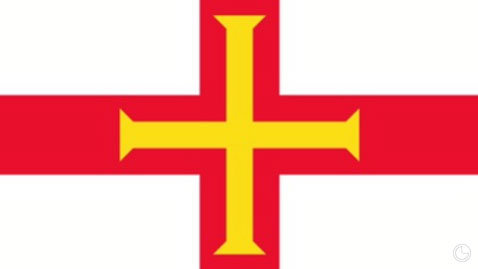
Each month we highlight a place of interest around the globe that we consider as unique as Borgo di Vagli. The tips are selected as they either show respect for the environment, nature, and architectural beauty or are deeply indigenous to their individual origin and this month we encapsulate all of these components. This month we highlight Lee’s recent trip home to Guernsey.
Our owners know how proud I am to come from Guernsey and that I try to endeavour to return whenever possible to catch up with my parents, siblings and other family members and friends. Last August was a special treat for me as I had arranged a father and son trip to coincide with a family event.

The logistics and weather always make traveling to Guernsey somewhat of a gamble and our trip started ominously enough when we were delayed at Florence airport due to a thunderstorm (it had been hovering between 30 and 35 degrees for months!). However we made good time and arrived at London Gatwick only 30 mins behind schedule, so far so good. We recovered our luggage and checked in with Aurigny, the Channel Islands local airline company. On checking-in, I asked if the flight was on time and the dreaded reply came; “a slight delay but keep an eye on the screens”. To cut a long story short we boarded 2 hours late and took off with clear skies over head, it wasn’t until 40 minutes into a 50 minute flight that the captain announced that we were having to circle as visibility was poor at Guernsey airport; another 30 minutes passed and we were told we had to fly back to Gatwick ahhh. Thomas couldn’t believe we were over the island but couldn’t land… Oh the joys of island hopping! We retrieved our luggage for the second time that day and checked-in at the Airport hotel.
We flew to Guernsey the following morning, only 1 hour delay, to be greeted by the entire Cogher clan. One of the many wonderful things you take for granted when you live on a small island is you can treat public places as your back garden - hugs, kisses and more hugs to the flashing cameras and hysteria. If bystanders didn’t know better they could be forgiven for thinking Thomas and I had just be released by a terrorist group.
A little history on Guernsey.
Guernsey, officially the Bailiwick of Guernsey a possession of the British Crown is in the English Channel off the coast of Normandy, France. As a bailiwick, Guernsey embraces not only all ten parishes on the island of Guernsey, but also the islands of Alderney and Sark – each with their own parliament – and the smaller islands of Herm, Jethou and Lihou.
Although its defence is the responsibility of the United Kingdom the Bailiwick is not part of the United Kingdom but rather a possession of the British Crown. It lies within the Common Travel Area of the British Isles and is not a member of the EU, but has a special relationship with it, being treated as part of the European Community for the purposes of free trade in goods.
Together, the Bailiwick of Guernsey and Bailiwick of Jersey form the geographical grouping known as the Channel Islands.
Around 6000 B.C., rising seas created the English and separated the Norman promontories that became the bailiwicks of Guernsey and Jersey from continental Europe. Neolithic farmers then settled on its coast and built the dolmens and menhirs found on the islands today.
During their migration to Brittany, Britons occupied the Lenur islands (the former name of the Channel Island) including Sarnia or Lisia (Guernsey) and Angia (Jersey). Travelling from the Kingdom of Gwent, Saint Sampson, later the abbot of Dol in Brittany, is credited with the introduction of Christianity to Guernsey.
In 933 the islands, formerly under the control of William I the Duchy of Brittany were annexed by the Duchy of Normandy. The island of Guernsey and the other Channel Islands represent the last remnants of the medieval Duchy of Normandy.
During the Middle Ages, the island was a haven for pirates that would use the "Lamping Technique" to ground ships close to her waters. This intensified during the Hundred Years War, when, starting in 1339, the island was occupied by the Capetians on several occasions.
In 1372, the island was invaded by Aragonese mercenaries under the command of Owain Lawgoch (remembered as Yvon de Galles), who was in the pay of the French king. Lawgoch and his dark-haired mercenaries were later absorbed into Guernsey legend as invading fairies from across the sea.
In the mid-16th century, the island was influenced by Calvinist reformers from Normandy. During the Marian persecution, three women, the Guernsey Martyrs, were burned at the stake for their Protestant beliefs.
During the English Civil War, Guernsey sided with the Parliamentarians. The allegiance was not total, however; there were a few Royalist uprisings in the southwest of the island, while Castle Cornet was occupied by the Governor, Sir Peter Osborne, and Royalist troops. Castle Cornet was the last Royalist outpost anywhere in the British Isles to surrender.
Wars against France and Spain during the 17th and 18th centuries gave Guernsey ship-owners and sea captains the opportunity to exploit the island's proximity to mainland Europe by applying for Letters of Marque and turning their merchantmen into privateers.
By the beginning of the 18th century, Guernsey's residents were starting to settle in North America. The 19th century saw a dramatic increase in prosperity of the island, due to its success in the global maritime trade, and the rise of the stone industry.
During WWI, approximately 3,000 island men served in the British Expeditionary Force.
For most of WWII, the Bailiwick was occupied by German troops. Before the occupation, many Guernsey children had been evacuated to England to live with relatives or strangers during the war. Some children were never reunited with their families. The occupying German forces deported some of the Bailiwick's residents to camps in the southwest of Germany, notably to the Lager Lindele (Lindele Camp) near Biberach an der Rib. Guernsey was very heavily fortified during the War out of all proportion to the island's strategic value. German defences and alterations remain visible.
Guernsey has a total area of 63.4 square kilometres (24.5 sq mi) and is situated 50 kilometres (31miles) west of France's Normandy coast and 120 kilometres (75 miles) south of Weymouth, England
Some interesting facts
Financial services, such as banking, fund management, and insurance, account for about 37% of GDP Tourism, manufacturing, and horticulture, mainly tomatoes and cut flowers, especially freesias, have been declining. The island has no national debt.
Taxation
Individuals resident in Guernsey pay income tax at the rate of 20%.
Guernsey has a 0% corporation tax rate on most companies.
• A 10% rate (income from banking business and, with effect from 1 January 2013, extended to domestic insurance business, fiduciary business, insurance intermediary business and insurance manager business)
• A 20% rate (income from trading activities regulated by the Office of the Director General of Utility Regulation, and income from the ownership of lands and buildings)
Guernsey levies no capital gains, inheritance, capital transfer, value added (VAT / TVA) or general withholding taxes.
Tourism
Guernsey, with its sandy beaches, cliff walks and sea scapes has been a tourist destination since at least the Victorian days.
The Parish of Saint Martin were my parents live won the small town category of Britain in Bloom twice in 2006 and 2011, and our little neighbouring island Herm has been awarded with both top tourist destination in 2012 and a small coastal resort category in 2008.
During our stay I was delighted to show Thomas around the Island and point out all of the places I played as a boy and the houses and hotels we’d lived in. Although I left Guernsey when I was 18, I couldn’t help but notice we moved a lot!


He swam with his cousins at Cobo beach on the west coast and was nearly out of breath by the time he reached the cold water (16 degrees) having run 300 meters down the beach to the water. We have incredible tides in this part of the world and it was low tide! I didn’t brave the water, but true “Guerns” of all ages were splashing about with glee, I couldn’t believe how long they stayed in the cold water without catching hypothermia, but smiled as a high number returned up the beach paler (some even pink!) than when they entered.
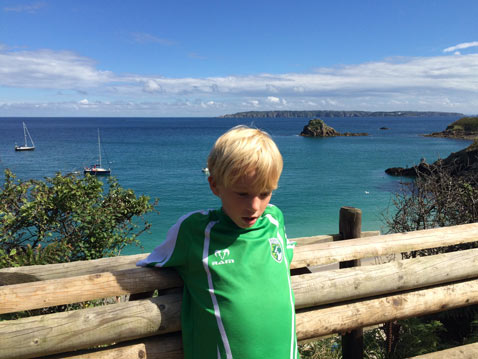
We enjoyed the local tradition of having “fish and chips” and a beer on the beach with my brother, niece and nephew and together marvelled as the sunset disappeared over the horizon. Truly one of the most memorable sights for any Guernsey-man. My brother told Thomas stories of when he and I used to fly our kites and play football on the beach – so many memories came flooding back and I couldn’t help but get nostalgic.
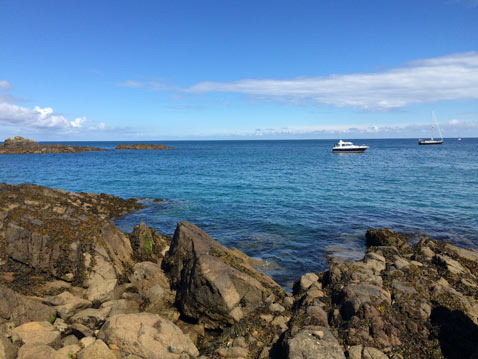
One late afternoon, we flew Thomas’ drone at a park near my parents home and close to where my Grandfather had a cattle farm before he passed away and was the last farmer to milk by hand. It was our solo flight and we scared the bejesus out of a very well-to-do lady, when at dusk, “his” drone (I was piloting it) with its flashing lights landed (dropped out of the sky) into her garden, I ran 100 meters and jumped over her well trimmed hedge to retrieve it just as she came out her house and with a wry smile said she’d thought she’d seen a UFO land in her garden through her curtains and I should know better and we should be more careful. I’d not been told off like that for a while!
Thomas shares my grandfather’s love for animals and he jumped over a fence to stroke the young curious heifers.

A fun trip my brother arranged was a ride on a rib (accompanied by my mother) to visit the caves of nearby island of Sark this was an adrenaline rush and fun on the high-seas. Our guide told us stories of when pirates and smugglers roamed between the Islands and how they used to hide their bounty in the caves at high tide and collect them later. The wild life here is stunning, numerous seas birds, including puffins and seals, jellyfish and sea bright and colourful sea-anemones.

A trip I was looking forward to was visiting the small Island of Herm as I have so many memories of Herm, my first kiss being one! Being dropped off at the harbour by the catamaran Travel Trident and, due the tide, having to walk what seemed like miles to rosaire steps to be picked up for the return trip back to Guernsey.
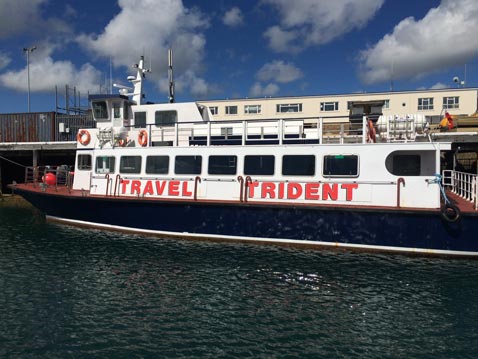
Herm is only 1.5 miles long and just under 0.5 miles wide; orientated north-south, with the most fantastic beaches and clear blue waters. During a busy summer season, up to 100,000 tourists visit the island and we visited Belvoir Bay and Shell beach, two of my favourites. Herm was first discovered in the Mesolithic period, and the first settlers arrived in the Neolithic and Bronze Ages. Many tombs from that period remain today, the majority in the north of the island. The island was annexed to the Duchy of Normandy in 933, but returned to the English Crown with the division of Normandy in 1204. It was occupied by Germany in the Second World War and the scene of Operation Huckaback.
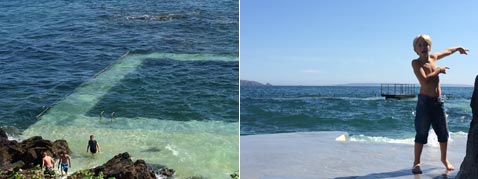
Another fun excursion was karting. My brother and I both share a healthy competitive spirit and our 15 minutes in a kart brought out that trait in both of us. We knocked our children off the track several times (our parents with mouths wide open were shaking their heads). We were both cautioned for dangerous driving (my technique was learned on the streets in Italy and his on the streets of Thailand) and after 15 minutes of no-holds-barred side by side driving down the straights and overtaking on the tight corners, I finished in front but he achieved the best lap time!! Some things never change.
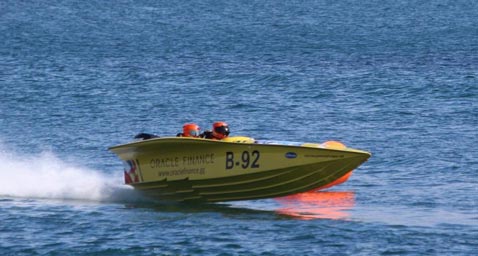
Another sport I loved as a boy and later as a young hotelier is powerboat racing and by sheer luck there were two meetings over the weekend. We sat on the seawall of the north beach (now a marina for expensive cabin cruisers and yachts) and watched these crazy men and women race only 100 meters away. A couple of boats blew their engines and one overturned, but that’s powerboat racing. What an adrenaline rush just to watch. I’ve raced in these boats and it’s frightening and that was 25 years ago! When I operated Wyndhams Hotel in the late eighties we sponsored Magician IV D-33 (footage can be seen here) , a four litre 25 foot phantom), that was back in the days when Guernsey hosted the International Powerboat Championship annually.
I could list 30 plus restaurants where to dine in Guernsey but my favourites are Le Petit Bistro, Da Nello, Mora’s, Absolute End, China Red and La Fregate (where I worked for 18 months before leaving for warmer climes of Tenerife in 86’). I returned to Guernsey in 88’ for 14 months to run Wyndham’s Hotel before returning to Tenerife to continue my career in sales and marketing.
